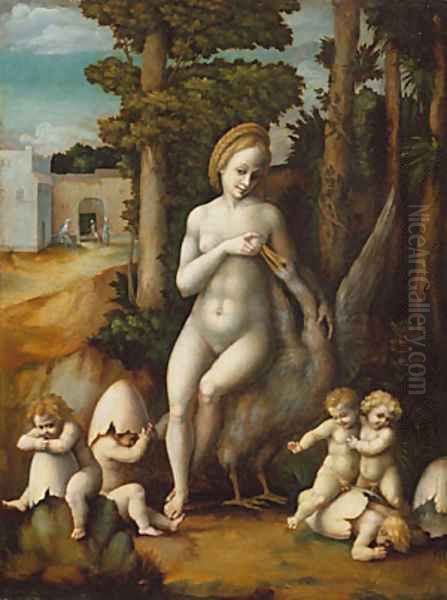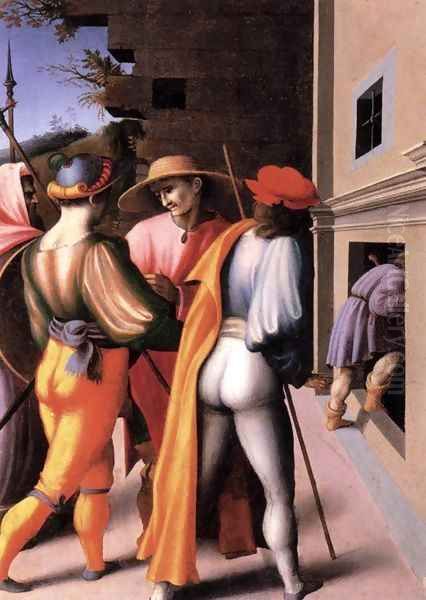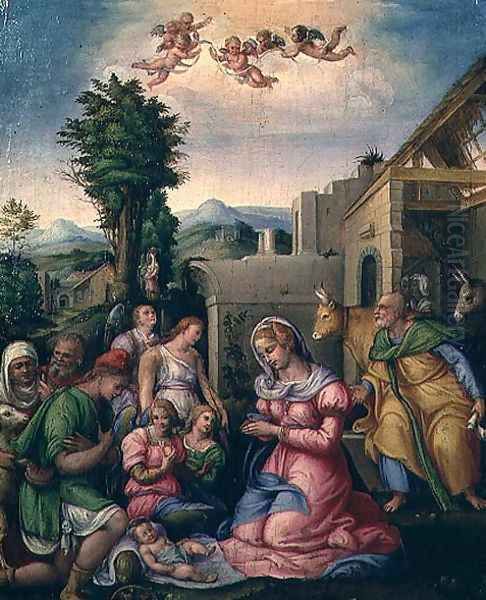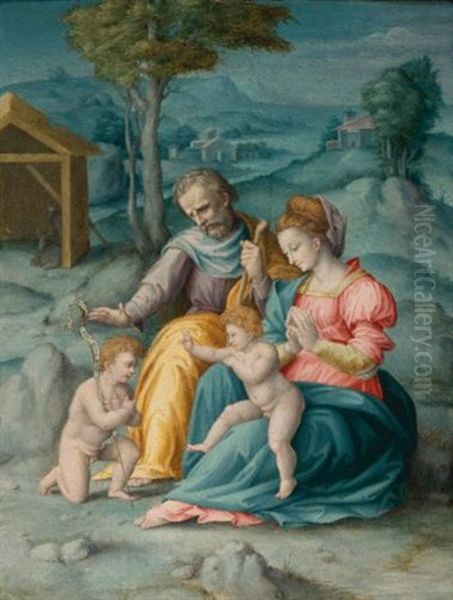Francesco d'Ubertino Verdi, more famously known by his nickname "Il Bacchiacca," stands as a significant, if sometimes overlooked, figure in the vibrant tapestry of the Italian Renaissance. Active primarily in Florence during the first half of the 16th century, Bacchiacca's art bridges the High Renaissance's classical harmony with the emergent stylistic innovations of Mannerism. His oeuvre, characterized by meticulous detail, a penchant for eclectic borrowing, and a delightful rendering of figures, flora, and fauna, offers a fascinating window into the artistic currents and patronage systems of his time. This exploration delves into the life, artistic development, key works, and cultural context of this intriguing Florentine painter.
Early Life and Artistic Formation
Francesco d'Ubertino Verdi was born on March 1, 1494, in Borgo San Lorenzo, a town situated not far from the bustling artistic hub of Florence. His father, Ubertino di Bartolomeo, was a goldsmith, a profession that often intersected with the world of painting and sculpture, providing young Francesco with an early exposure to craftsmanship and design. This familial connection to the arts likely played a role in nurturing his nascent talents. His elder brother, Antonio d'Ubertino Verdi, also pursued an artistic career, known as "Bacchiacca" as well, and was skilled in embroidery and painting, further embedding Francesco in a creative environment.
The most formative period of Bacchiacca's early training was spent in the workshop of Pietro Perugino, one of the leading masters of the Umbrian school and a prominent figure in late Quattrocento and early Cinquecento Florence and Rome. Perugino, known for his serene compositions, sweet-faced Madonnas, and harmonious landscapes, would have imparted to his apprentice a solid grounding in traditional techniques, including panel painting, fresco, and the principles of perspective and figure drawing. The influence of Perugino's gentle lyricism can be discerned in some of Bacchiacca's earlier works, particularly in the rendering of tranquil expressions and balanced compositions.

However, Florence in the early 16th century was a crucible of artistic innovation, and young Bacchiacca was soon exposed to a wider array of influences that would shape his evolving style. The city was still reverberating with the monumental achievements of Leonardo da Vinci, Michelangelo Buonarroti, and Raphael Sanzio, whose works were transforming the very language of art.
The Florentine Crucible: Influences and Collaborations
Upon completing his apprenticeship, Bacchiacca found himself amidst a dynamic artistic scene. While the towering figures of the High Renaissance cast long shadows, a new generation of artists was beginning to explore different modes of expression. Bacchiacca's artistic development was significantly shaped by his interactions and associations with several key Florentine painters.
Among his most important early influences was Andrea del Sarto, a leading painter of the High Renaissance in Florence, known as "the faultless painter" for his technical mastery and graceful compositions. Bacchiacca is believed to have worked alongside or been closely associated with del Sarto, and the latter's impact is evident in Bacchiacca's richer color palettes, softer modeling of forms, and more complex figure arrangements. He also absorbed influences from Franciabigio (Francesco di Cristofano), another prominent contemporary and sometime collaborator of Andrea del Sarto, whose work shared a similar Florentine grace.
Furthermore, Bacchiacca was part of a circle of artists that included Jacopo Pontormo and Rosso Fiorentino, two of the earliest and most radical exponents of Mannerism. This emerging style, characterized by elongated figures, stylized forms, subjective use of color, and often unsettling emotional intensity, represented a departure from the classical balance and naturalism of the High Renaissance. While Bacchiacca's art never fully embraced the extreme contortions or emotional angst of Pontormo or Rosso, he selectively incorporated Mannerist elements, such as a heightened sense of artifice, intricate details, and a tendency towards decorative complexity.
He also collaborated with other artists on decorative projects. For instance, around 1523, Bacchiacca, Andrea del Sarto, Jacopo Pontormo, and Francesco Granacci were commissioned to decorate the antechamber of Giovanni Benintendi. For this project, Bacchiacca painted scenes from the life of John the Baptist, demonstrating his ability to work within a collaborative framework and adapt his style to specific thematic and decorative requirements. This project highlights his integration into the mainstream of Florentine artistic production.
The Development of a Unique Style

Bacchiacca's mature style is often described as eclectic, a thoughtful synthesis of various influences rather than a slavish imitation of any single master. He possessed a remarkable ability to absorb and reinterpret motifs and compositional ideas from a wide range of sources, including the works of his Italian contemporaries, as well as Northern European prints, particularly those by artists like Albrecht Dürer and Lucas van Leyden, which were circulating in Italy at the time.
This eclecticism is a hallmark of his art. He would often borrow figures or landscape elements from different artists and weave them into his own compositions, creating a rich, densely packed visual narrative. This practice has sometimes led to criticism of a lack of originality, but it can also be seen as a testament to his visual acuity and his skill in creating harmonious, albeit composite, new wholes. His nickname, "Il Bacchiacca," which translates roughly to "the berry" or perhaps implies a "collector" or "gatherer," might even allude to this tendency to collect and incorporate diverse visual elements.
A defining characteristic of Bacchiacca's style is his meticulous attention to detail. He excelled in rendering intricate patterns in textiles, the delicate forms of flowers and plants, and the varied textures of animal fur and feathers. This precision made his works particularly appealing for intimate viewing, such as in small panel paintings, cassone (marriage chest) panels, and other decorative items for domestic interiors. His figures, often small in scale, are rendered with a jewel-like precision, and his compositions are frequently enlivened by an abundance of flora and fauna, depicted with an almost botanical or zoological accuracy.
His color palette is typically bright and varied, often employing rich blues, vibrant reds, and luminous greens. While he could achieve a sense of depth and volume, his compositions sometimes favor a more decorative, surface-oriented approach, characteristic of Mannerist tendencies. The figures, though anatomically sound, can exhibit a certain stylization, with elegant gestures and refined, if sometimes emotionally reserved, expressions.
Key Themes and Subject Matter
Bacchiacca's artistic output was diverse, encompassing religious scenes, mythological narratives, allegories, and portraits, though he is perhaps best known for his smaller-scale works and decorative panels.

Religious subjects formed a significant part of his oeuvre. He painted numerous Madonnas and Holy Families, often set in lush landscapes filled with symbolic plants and animals. His depictions of scenes from the lives of saints, such as John the Baptist, were also common. These works, while adhering to traditional iconography, are often imbued with Bacchiacca's characteristic charm and attention to anecdotal detail. For example, his Baptism of Christ showcases his ability to handle multi-figure compositions within a detailed landscape setting.
Mythological and allegorical themes provided Bacchiacca with opportunities to explore more dynamic compositions and to indulge his interest in exotic costumes and settings. Stories from Ovid's Metamorphoses, such as Leda and the Swan, were popular subjects during the Renaissance, allowing artists to depict the nude figure and explore themes of love and transformation. Bacchiacca approached these subjects with his typical refinement and decorative sensibility.
His skill in depicting animals and natural elements was particularly noteworthy. Whether as part of a larger narrative or as primary subjects, animals are rendered with vivacity and accuracy. This affinity for the natural world extended to his detailed portrayal of plants and flowers, which often carry symbolic meanings within his compositions. This focus on the particular and the detailed aligns with a broader Renaissance interest in the natural world, spurred by new discoveries and a burgeoning scientific curiosity.
Bacchiacca was also involved in creating designs for tapestries and other decorative arts, a field that required a strong sense of pattern, color, and narrative clarity. His ability to create intricate and visually engaging compositions made him well-suited for such commissions.
Masterpieces and Notable Works
Several works stand out as representative of Bacchiacca's style and artistic achievements.
The Beheading of Saint John the Baptist (or Execution of St. John the Baptist): This work, now in the Gemäldegalerie, Berlin, is one of his most famous. It exemplifies his skill in narrative composition, his use of vibrant color, and his detailed rendering of figures and costumes. The scene is dramatic, yet handled with a certain Mannerist elegance. The figures, though engaged in a grim event, possess a stylized grace.
Adam and Eve with their Children: Housed in the Metropolitan Museum of Art, New York, this painting showcases Bacchiacca's ability to integrate figures into a lush, detailed landscape. The influence of Northern European art, particularly in the meticulous rendering of foliage and the anecdotal details, is apparent. The work is rich in symbolism and demonstrates his skill in depicting the human form and conveying a narrative.

Madonna and Child with the Infant Saint John the Baptist: Bacchiacca painted several variations of this popular theme. These works often feature his characteristic sweet-faced Madonna, chubby Christ Child, and a landscape filled with carefully observed natural details. An example can be found in the Virginia Museum of Fine Arts. These paintings were likely intended for private devotion and highlight his ability to create intimate and appealing religious imagery.
Leda and the Swan: Also in the Metropolitan Museum of Art, this mythological scene demonstrates Bacchiacca's engagement with classical themes. The composition is elegant, and the figures are rendered with a smooth, polished finish. The inclusion of detailed landscape elements and attendant figures adds to the richness of the scene.
A Lady with a Music Book (Portrait of a Young Woman with a Music Book): This portrait, in the Getty Museum, Los Angeles, showcases Bacchiacca's skill in portraiture. The sitter is depicted with a refined elegance, and the attention to the details of her costume and the music book is characteristic of his meticulous approach. The use of perspective, for instance in the receding columns and vase, adds depth to the composition.
Gathering Manna: This complex, multi-figure composition, part of a series for the Borgherini-Salviati nuptial chamber, demonstrates his ability to handle large-scale narrative scenes. The work is filled with lively figures and intricate details, showcasing his storytelling abilities and his capacity to synthesize various influences into a cohesive whole.
These works, among others, illustrate the range of Bacchiacca's talents, from intimate devotional pieces to more complex narrative and mythological scenes. They consistently display his hallmark attention to detail, his eclectic borrowing, and his refined, decorative sensibility.
Patronage and the Medici Court
Like many artists of his time, Bacchiacca relied on patronage from wealthy individuals, religious institutions, and civic bodies. His ability to create charming and highly detailed works made him popular with private patrons seeking paintings for their homes, particularly for spalliere (wainscoting panels) and furniture decoration.

Later in his career, Bacchiacca received commissions from the Medici family, who had returned to power in Florence and were significant patrons of the arts. He worked for Duke Cosimo I de' Medici, contributing to various decorative projects for the Palazzo Vecchio, the seat of Florentine government. This included designing tapestries for the Sala dell'Udienza and the Sala dei Duecento, a prestigious commission that involved collaboration with other leading artists like Agnolo Bronzino and Francesco Salviati. His tapestry designs, such as the "Grotesques" series, demonstrate his imaginative flair and his ability to work in a medium that required bold, clear compositions.
His involvement with the Medici court indicates his established reputation in Florence. Working for such powerful patrons provided not only financial stability but also enhanced an artist's prestige. The decorative tastes of the Medici court, which favored elaborate and often allegorical imagery, aligned well with Bacchiacca's skill in creating intricate and richly detailed compositions. He was also appointed a court painter, a testament to his standing.
Bacchiacca and His Contemporaries
Bacchiacca's career unfolded during a period of intense artistic activity and transformation in Florence and beyond. His relationship with his contemporaries was one of both influence and, at times, friendly rivalry.
As mentioned, his early training with Pietro Perugino provided a foundational understanding of Renaissance principles. His association with Andrea del Sarto was crucial, exposing him to the height of Florentine High Renaissance classicism and technical finesse. Del Sarto's workshop was a hub of talent, and artists like Jacopo Pontormo and Rosso Fiorentino, who also passed through or were associated with del Sarto, went on to become pioneers of Mannerism. Bacchiacca navigated a path between del Sarto's classicism and the more experimental tendencies of Pontormo and Rosso.
The giants of the High Renaissance, Leonardo da Vinci, Michelangelo, and Raphael, though largely active elsewhere or deceased by the latter part of Bacchiacca's career, continued to exert a profound influence. Bacchiacca, like many of his generation, studied their works, borrowing compositional ideas or figural motifs. For instance, the dynamism and anatomical understanding evident in Michelangelo's figures, or the sfumato and psychological depth of Leonardo's, were part of the artistic lexicon that Bacchiacca could draw upon. Raphael's harmonious compositions and graceful figures also remained an ideal.
In the realm of decorative arts and courtly patronage, Bacchiacca worked alongside artists like Agnolo Bronzino, the preeminent court painter to Cosimo I, known for his coolly elegant and highly polished Mannerist portraits and allegories. Francesco Salviati, another prominent Mannerist active in Florence and Rome, also collaborated on projects for the Medici. Giorgio Vasari, the artist and art historian, was a contemporary who documented the lives of many artists, including Bacchiacca, in his Lives of the Most Excellent Painters, Sculptors, and Architects. Vasari's accounts, though sometimes biased, provide invaluable insights into the artistic milieu of the time.
Bacchiacca's eclecticism also suggests an awareness of art beyond Florence. The influence of Northern European artists like Albrecht Dürer and Lucas van Leyden, primarily through their widely circulated prints, is evident in his attention to detail and certain iconographic motifs. He was not alone in this; many Italian artists were fascinated by the technical skill and novel subjects of Northern prints. Even Sienese contemporaries like Domenico Beccafumi were exploring their own distinct paths within the broader Mannerist movement. The workshop of Fra Bartolommeo, another key figure of the Florentine High Renaissance, also contributed to the city's rich artistic environment.
The Man Behind the Easel: Anecdotes and Character
Giorgio Vasari provides some biographical details about Bacchiacca, portraying him as a diligent artist, though perhaps not an innovator on the scale of Michelangelo or Raphael. Vasari notes his skill in depicting animals and plants, a talent highly valued for decorative works.
The origin of the nickname "Il Bacchiacca" is not definitively known. As mentioned, it could relate to "bacca" (berry) or imply a "gatherer" of images, reflecting his eclectic style. It was a name shared with his embroiderer brother, Antonio, which suggests it might have been a family moniker or had a specific local connotation.
Bacchiacca's versatility was a key aspect of his career. He was not confined to panel painting but also engaged in fresco work, designs for tapestries, festival decorations, and possibly even stage sets. This adaptability was essential for an artist seeking to thrive in the competitive Florentine art world. His willingness to collaborate on large-scale projects, such as the Benintendi antechamber or the Medici tapestry series, further underscores his professional acumen.
His friendship and collaboration with Andrea del Sarto were significant. Del Sarto was known for his amiable personality, and their association likely provided Bacchiacca with both artistic guidance and professional opportunities. The story of their joint work for Giovanni Benintendi's study illustrates the collaborative nature of many Renaissance commissions, where artists with different strengths might contribute to a unified decorative scheme.
Bacchiacca married Tommasa di Carlo d'Antonio in 1527, and they had several children. His son, Carlo d'Ubertino Verdi (known as Carlo Bacchiacca or Bacchiacca II), also became a painter, continuing the family's artistic legacy, though his work is less well-known than his father's. Another son, Bartolomeo (Baccio), also seems to have been an artist. This continuation of the artistic profession within the family was common during the Renaissance.
The Renaissance Context: Florence in Bacchiacca's Time
To fully appreciate Bacchiacca's art, it is essential to understand the socio-cultural environment of 16th-century Florence. The city, long a powerhouse of the Renaissance, was undergoing significant political and cultural shifts.
Economically, Florence remained a major center of banking, trade, and textile production, particularly wool and silk. This wealth fueled artistic patronage, both from powerful families like the Medici and Strozzi, and from the various guilds that played a crucial role in the city's civic and economic life. The demand for art to adorn palaces, churches, and public buildings was substantial.
Politically, Florence experienced periods of republican rule interspersed with Medici dominance. Bacchiacca's career spanned the later phases of the Florentine Republic and the consolidation of Medici power under Duke Cosimo I, who established a more autocratic ducal state. This political stability, under Cosimo, led to large-scale artistic projects aimed at glorifying the Medici dynasty and the Florentine state.
Culturally, Florence was steeped in Humanism, the intellectual movement that emphasized the study of classical antiquity and human potential. While the initial fervor of the High Renaissance, with its optimistic pursuit of classical ideals, was waning, its legacy remained potent. The rise of Mannerism can be seen, in part, as a response to the achievements of the High Renaissance masters – a search for new modes of expression once the classical ideal had been, in a sense, perfected. There was also a growing interest in esoteric knowledge, allegory, and complex iconography, which found expression in Mannerist art.
Religious life was also undergoing transformation. The Protestant Reformation, which began in Northern Europe in the early 16th century, had repercussions throughout Christendom, leading to the Catholic Counter-Reformation. While Florence remained staunchly Catholic, the period was one of religious introspection and, at times, turmoil. This context influenced religious art, which sometimes took on a more intense or didactic character.
The city itself was a vibrant urban environment, a center of craftsmanship, intellectual discourse, and artistic innovation. Artists' workshops were places of learning and production, and there was a constant exchange of ideas and techniques. The availability of classical texts, the presence of important art collections, and the tradition of artistic excellence all contributed to Florence's status as a leading cultural center.
Legacy and Collections
Francesco Ubertini, "Il Bacchiacca," died in Florence on October 5, 1557, and was buried in the church of San Lorenzo. He left behind a substantial body of work that reflects the artistic currents of his time. While he may not be as universally recognized as some of his more famous contemporaries, his paintings are valued for their charm, meticulous detail, and decorative appeal.
His works are found in major museums and collections around the world. In Italy, his paintings can be seen in the Uffizi Gallery and the Pitti Palace in Florence, among other collections. Internationally, significant holdings of his work are in:
The Gemäldegalerie, Berlin (e.g., The Beheading of Saint John the Baptist)
The Metropolitan Museum of Art, New York (e.g., Adam and Eve with their Children, Leda and the Swan)
The National Gallery, London
The National Gallery of Art, Washington D.C. (e.g., The Gathering of Manna, The Moors' Banquet, Crucifixion of Christ)
The J. Paul Getty Museum, Los Angeles (e.g., Portrait of a Young Woman with a Music Book)
The Virginia Museum of Fine Arts, Richmond (e.g., Madonna and Child with the Infant Saint John the Baptist)
The Borghese Gallery, Rome
His art has been featured in various exhibitions dedicated to the Florentine Renaissance and Mannerism, such as "Florentine Renaissance: Art of the Medici Court," helping to bring his contributions to a wider audience. Art historians continue to study his work, reassessing his role in the transition from High Renaissance to Mannerism and his unique synthesis of diverse artistic influences.
Bacchiacca's legacy lies in his ability to create visually engaging and intricately detailed works that appealed to the sophisticated tastes of his Florentine patrons. He was a master of narrative and decoration, and his paintings offer a delightful glimpse into the imaginative world of a skilled and versatile Renaissance artist.
Conclusion
Francesco d'Ubertino Verdi, "Il Bacchiacca," was a distinctive voice in the chorus of 16th-century Florentine art. Nurtured in the workshop of Perugino and responsive to the innovations of Andrea del Sarto, Michelangelo, and the early Mannerists, he forged a personal style characterized by meticulous craftsmanship, eclectic borrowing, and a charming decorative sensibility. His paintings, whether depicting religious scenes, mythological tales, or portraits, are enlivened by a profusion of carefully observed details, particularly in the rendering of flora, fauna, and textiles.
As a court artist for Duke Cosimo I de' Medici, Bacchiacca contributed to the splendor of Medicean Florence, designing tapestries and participating in other decorative projects. His ability to adapt his talents to various media and his skill in creating intricate, jewel-like compositions ensured his success in a competitive artistic environment. Though perhaps overshadowed by some of the titans of his era, Bacchiacca's art remains a testament to the richness and diversity of the Italian Renaissance, offering enduring visual pleasure and a fascinating insight into the artistic culture of his time. His works continue to be appreciated in collections worldwide, securing his place as a noteworthy master of Florentine Mannerism.